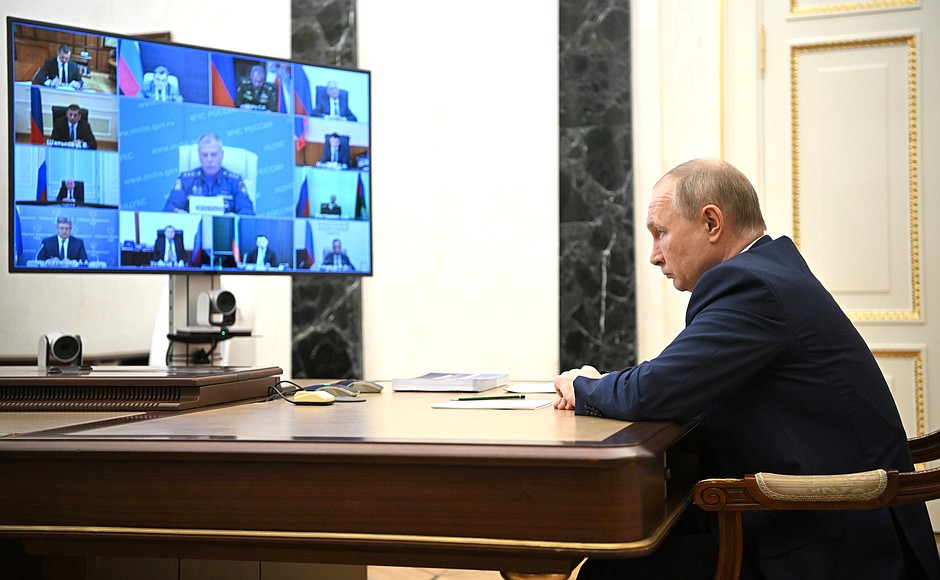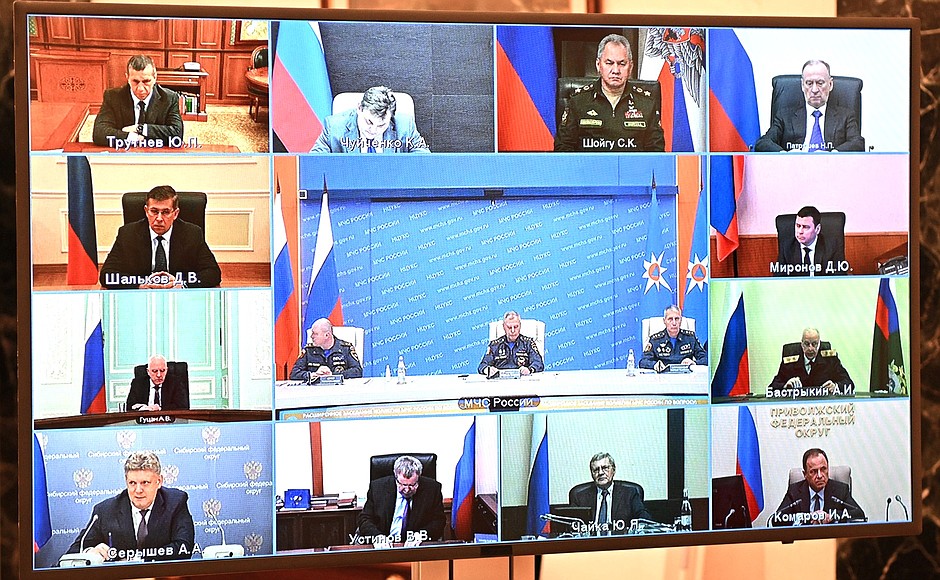President of Russia Vladimir Putin: Comrades, good afternoon.
We have always paid serious attention to the activities of the Ministry of Emergencies and will continue to do so. Today, at the annual expanded meeting of the Ministry Board, we will discuss your performance in 2021 and outline priority tasks for the future.
Let me note that over the last three decades the Ministry has proven in practice that it is an essential and highly needed link in Russia’s security system. It has become a flawless, mobile, and well-equipped organisation responsible for protecting our citizens in emergencies, as well as preventing and extinguishing fires and developing the civil defence system.
Last year was difficult for the ministry. Floods in Siberia, in the Far East and in the south of Russia were an important test for rescue crews. They fought natural and man-made fires that threatened people and property.
A major effort was carried out in response to the Listvyazhnaya Mine accident. This tragedy, which unfortunately killed several people – miners and rescuers – was the pain and misfortune of Kuzbass and the rest of Russia.
And, of course, our people are grateful for the substantive aid you have provided in countering the coronavirus. Since the beginning of the pandemic, the ministry’s experts have disinfected more than 40,000 social institutions and decontaminated over 46,000 transport infrastructure facilities, along with almost 12,000 kilometres of roads.
You also fulfilled an important mission abroad during these difficult months. During the general lockdown when the borders were closed, Emergency Ministry planes helped evacuate Russians who were abroad on business trips or holidays. Over 1,400 tonnes of medical equipment and medicines, 120 tonnes of food and over 380,000 doses of Sputnik V and Sputnik Light vaccines were delivered to the countries that suffered most from the coronavirus.
I would like to thank the managers, the military personnel, the employees and civilian specialists at the Emergencies Ministry for their dutiful work and their courage and selflessness in performing their duties, for their readiness to immediately help others, often at the risk of their own lives.
Colleagues,
To be clear, the demands on your work are always the toughest. Today, Emergencies Ministry forces and equipment, and your territorial units must respond more efficiently to all possible emergencies. To do so, operational, analytical and personnel capabilities must be built up and the ministry must be provided with the latest equipment. This must be done in a systemic and consistent way, in full conformity with existing plans.
I will note that that last year a programme was approved for the first time to re-equip the Emergencies Ministry with modern types and models of firefighting and aviation equipment. This has been on the agenda for a long time. Significant funding amounting to almost 190 billion rubles is being allocated for the programme until 2030.
It is especially important to upgrade firefighting and rescue units, to increase their mobility and readiness to immediately respond to natural and industrial threats. As such, I think it is necessary to focus on resolving the following priority tasks.
First, we need to supply the Emergencies Ministry with modern vehicles and equipment. By 2030 new rescue equipment must make up at least 81 percent and fire engines at least 56 percent.
In view of the history of cooperation with the largest manufacturers of this equipment, primarily KamAZ and Ural, the issue of signing long-term contracts must be considered while ensuring transparent pricing, cutting delivery time and streamlining servicing by signing “life-cycle” contracts.
Special care should be taken to improve the gear and equipment for firefighters and rescuers, reflecting the local climate and other peculiarities, which are different in different regions due to the huge size of the country.
In addition, training equipment for Emergencies Ministry personnel must be improved, primarily for mine-rescuers.
With this in mind, I will note that this year, which marks the centenary of the mine rescue service in Russia, the core facilities of the National Airmobile Rescue Training Centre for mine-rescuers and miners must begin operating. It is a crucial task, so please note that up-to-date training that meets all standards is utterly important for operating with efficiency in case of an emergency.
Now, about the second aspect – organisation. The ministry’s efficiency gains will largely come from eliminating duplicate structures, mainly in management and supply divisions. The resources freed up should be diverted to operational rescue and fire services and units, and also to increase the number of inspectors in supervising bodies.
Third. Preventing man-made fires remains a priority. They are a grave threat to people’s health and lives and are associated with large economic losses.
Yes, the state is consistently removing the inspection burden on businesses, and this is the right thing to do, especially for small and medium-sized businesses. The Emergencies Ministry was among the first to assume a risk-based approach to inspection activities. However, it does not mean that if companies are not inspected in the old way, they can ignore established rules and standards, much less blatantly violate them. Responsibility for fire safety and people’s health has to be of the utmost importance.
I must add that the Emergencies Ministry has to get more involved with public volunteer associations and volunteers while addressing these issues. This concerns not only firefighting or emergency relief operations but also prevention work including teaching citizens safe habits.
Volunteer firefighting teams and units and other associations are a great help in your work, and so we need to consider the issue of transferring retired but otherwise fully functioning equipment of the Emergencies Ministry to volunteer firefighting units. I want to stress: not faulty, retired but fully functioning, otherwise it makes no sense. Salvage and unwanted equipment cannot be just dumped on people who will not be able to use it. Instead, it would only be a hazard.
Fourth – the development of the emergencies and rescue infrastructure in the Arctic region. Significant federal funding is to be allocated to address this task. For example, providing the Emergencies Ministry with latest Arctic-type helicopters will cost over 18 billion rubles.
In 2021, the formation of a rescue centre in Pevek, Chukotka Autonomous Area began; it was scheduled to begin and is reported to have already begun. However, note that this work requires more interaction with large companies that have hydrocarbon extraction and processing facilities in the Arctic such as Novatek and Rosneft. All that will allow for more efficient use of budget funds.
And, finally, fifth. The ongoing work on increasing the efficiency of the civil defence system must be continued.
The state, for its part, will continue to further enhance social guarantees for those employed by the Ministry. Over a thousand of the Ministry’s employees have been provided with housing in the past three years. Allowances for service personnel and employee wages were duly adjusted. I know that some problems remain here, but this work will continue, obviously.
I am confident that Emergencies Ministry personnel will act professionally and decisively to address the issues raised today and other challenges facing the Ministry.
I wish you success in your work for the good of Russia and our citizens.
Thank you.
<…>

